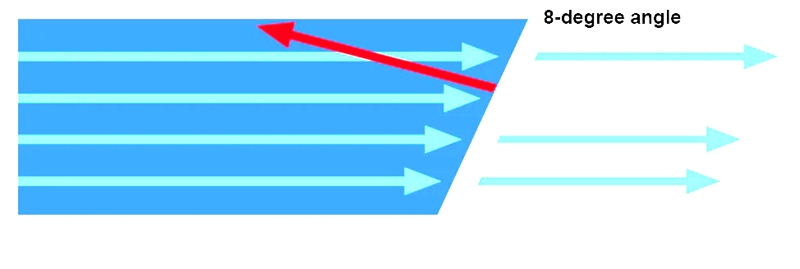AI workloads, particularly those involving large language models (LLMs) and deep learning, require massive parallel data transfers between GPUs and TPUs at speeds of 100G, 400G, and beyond. To support these demands, data centers are transitioning to PAM4 (Pulse Amplitude Modulation 4-level) signaling, which doubles the efficiency of traditional NRZ encoding. However, PAM4’s narrower eye diagram makes it highly sensitive to signal degradation—especially from reflections in fiber optic connections.
PAM4’s four-level signaling (00, 01, 10, 11) enables higher data rates but is more prone to interference. Even minor reflections—caused by dust, scratches, or imperfect connectors—can scatter light back to the transmitter, distorting signals and increasing bit error rates (BER). This leads to:
Retransmissions, increasing latency
Longer AI training cycles, raising operational costs
Reduced efficiency in high-performance computing (HPC) environments

Figure 1: PAM4’s narrower eye diagram makes it more vulnerable to noise than NRZ.
Most multimode MTP®/MPO fiber cables (e.g., 12/24-fiber variants) use UPC (Ultra Physical Contact) polishing, which has a slight curvature to reduce reflections. While effective for older NRZ-based networks, UPC endface struggles with PAM4’s demands because:
Multimode fibers have larger cores, allowing multiple light modes that create complex reflections.
UPC’s flat polish doesn’t fully eliminate back reflections at 100G/400G/800G speeds.
Higher return loss increases the risk of signal distortion.
APC (Angled Physical Contact) connectors feature an 8° angled polish (vs. UPC’s flat surface). This design:
Redirects reflected light into the cladding, where it’s absorbed instead of bouncing back.
Lowers return loss, improving signal integrity for PAM4 modulation.
Supports higher data rates (400G/800G) with minimal interference.

Figure 2: APC’s angled end-face prevents reflections from reaching the transmitter.
Feature | MTP®/MPO APC | MTP®/MPO UPC |
Reflection | Light absorbed by cladding | Partial reflections remain in core |
Speed Support | Optimized for 400G/800G PAM4 | Limited performance at high speeds |
Cost | Slightly higher due to precision polish | Lower cost, but higher risk of errors |
To meet the needs of AI-driven infrastructures, T&S offers high-performance APC optical fiber solutions, including:
Low-reflection design for stable 400G/800G transmission
OM4/OM5 compatibility for future-ready scalability
Custom configurations (8/12/16/24/36-fiber or more fiber count options)
Application | Cables | Transceivers |
400G Networks | MTP®-12 APC to MTP®-12 APC, OM4 | 400GBASE-SR4 QSFP-DD |
800G Networks | MTP®-16 APC to MTP®-16 APC, OM4 | 800GBASE-SR8 OSFP |
Breakout | MTP®-16 APC to 8x LC UPC, OM4 | 400GBASE-SR8 QSFP-DD |
As AI workloads push data rates beyond 400G, minimizing reflections is critical. T&S’s MTP®/MPO APC fiber solutions ensure:
Lower return loss for cleaner PAM4 signals
Higher reliability in dense AI/ML environments
Seamless compatibility with InfiniBand and Ethernet standards
Upgrade to APC today—optimize your AI infrastructure for speed and stability. Visit link below to explore the right products to upgrade your MPO/MTP® cabling projects: https://www.china-tscom.com/products/mpo-mtp-cable-assembly/
 Comprehensive Guide to Installing and Maintaining Fiber Optic Module Cassettes
21 Dec 2024
Fiber optic module cassettes are indispensable in modern optical networks, providing a modular and efficient solution for managing fiber connections in high-density environments. Whether for data cent...
Comprehensive Guide to Installing and Maintaining Fiber Optic Module Cassettes
21 Dec 2024
Fiber optic module cassettes are indispensable in modern optical networks, providing a modular and efficient solution for managing fiber connections in high-density environments. Whether for data cent...
 Call us on:
Call us on:  Email Us:
Email Us:  8 Jinxiu Middle Road,
8 Jinxiu Middle Road,